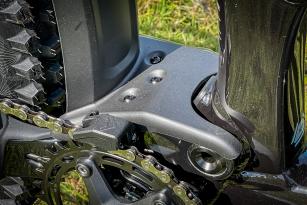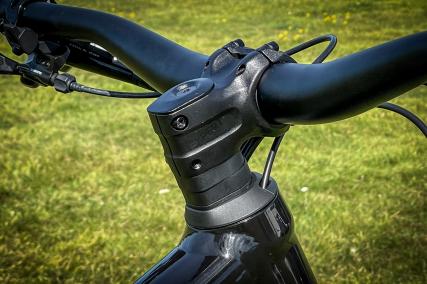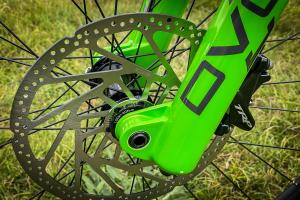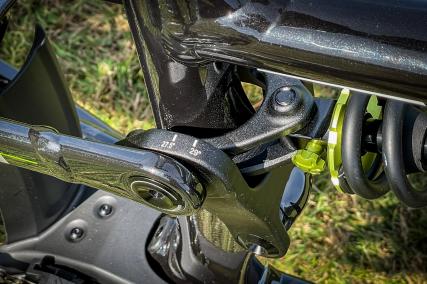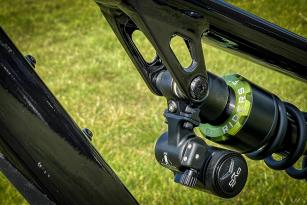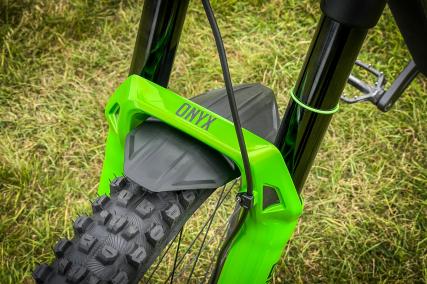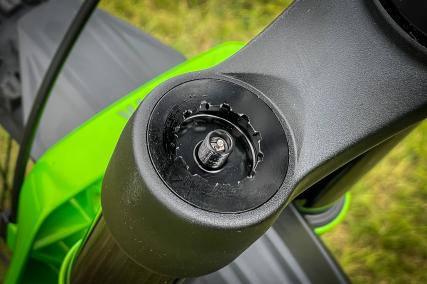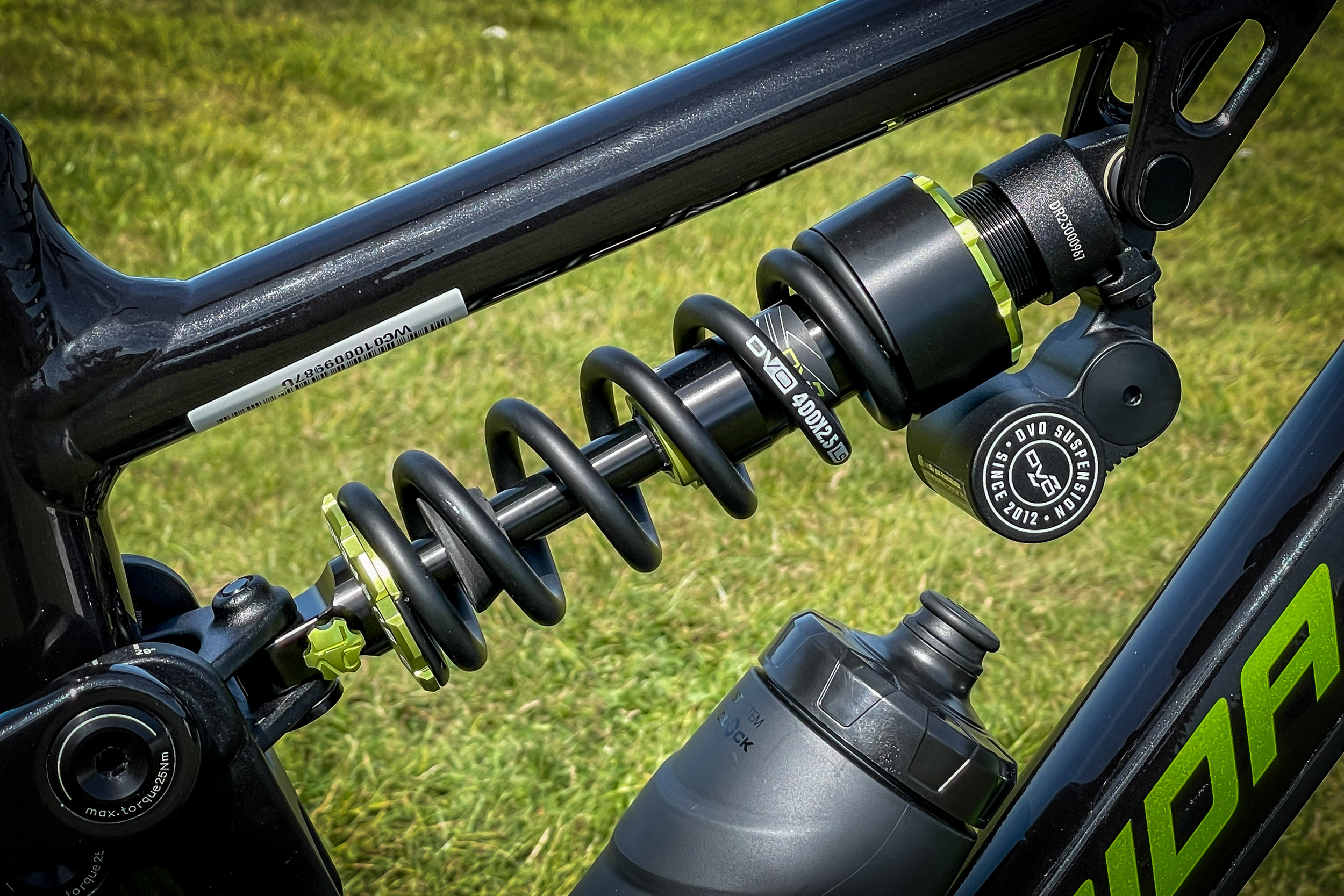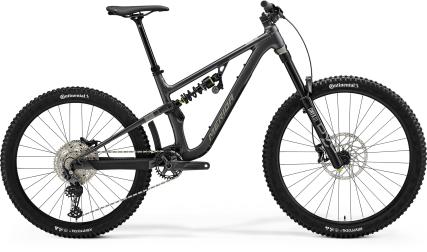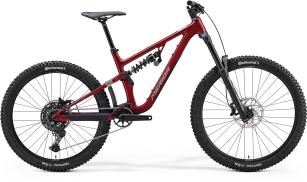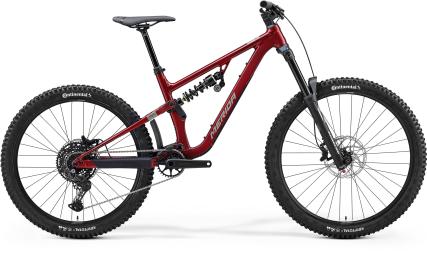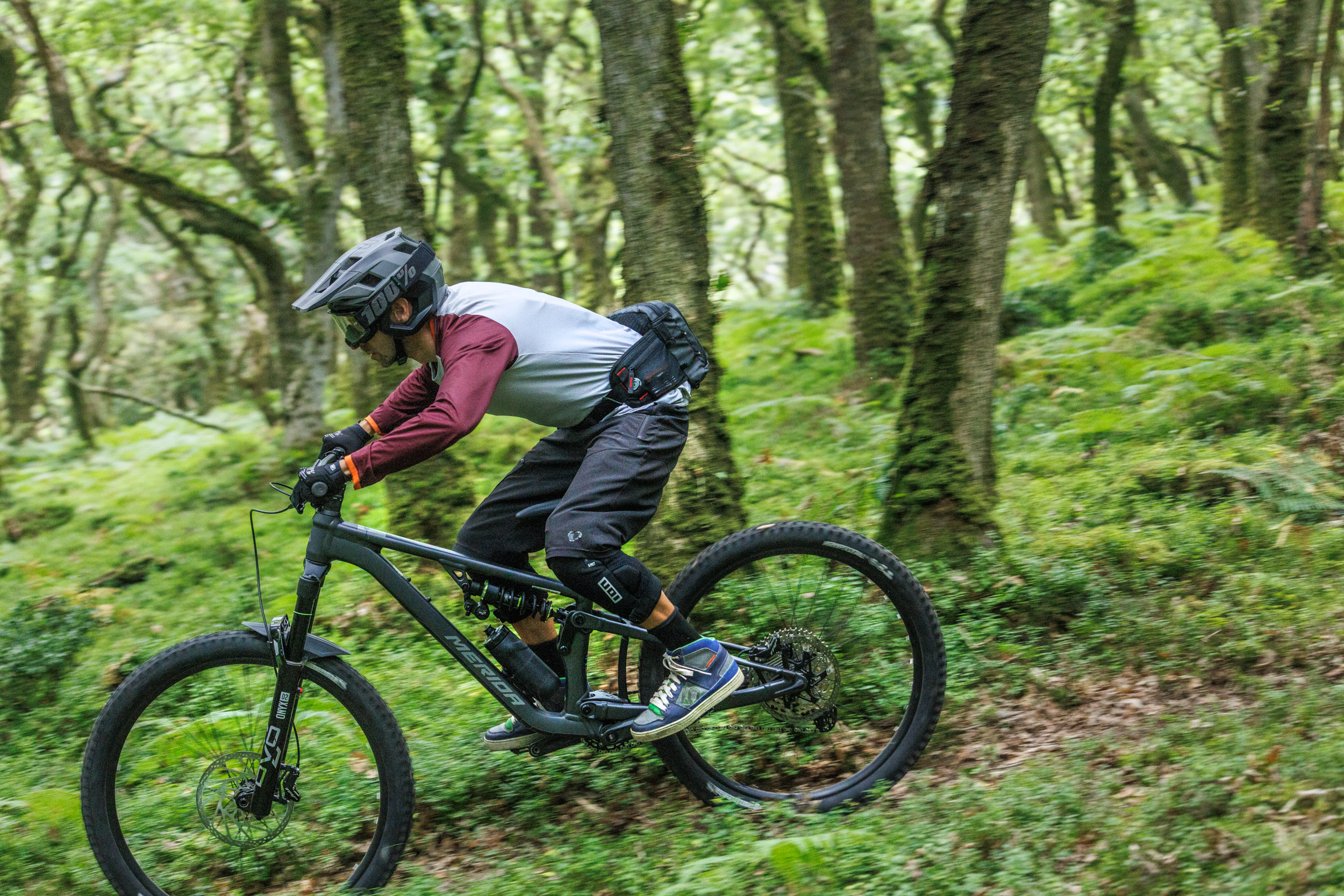
Merida One-Sixty FR First Ride Review
22.09.23 10:35 4282023-09-22T10:35:00+02:00Text: Ralf Hauser (translated by AI)Photos: Paul Box, Merida, NR22With 180 mm of travel at the front and 171 mm at the rear, Merida is going all out with the One-Sixty FR. Coil shock, mixed wheel setup, and robust equipment are in the foreground, as well as the high fun factor and the inviting price tag.22.09.23 10:35 9842023-09-22T10:35:00+02:00Merida One-Sixty FR First Ride Review
22.09.23 10:35 9842023-09-22T10:35:00+02:00 Ralf Hauser (translated by AI) Paul Box, Merida, NR22With 180 mm of travel at the front and 171 mm at the rear, Merida is going all out with the One-Sixty FR. Coil shock, mixed wheel setup, and robust equipment are in the foreground, as well as the high fun factor and the inviting price tag.22.09.23 10:35 9842023-09-22T10:35:00+02:00The frame of the One-Sixty FR is not a new development but corresponds to that aluminum model of the regular One-Sixty. Therefore, it shares its construction, features, and characteristics.
The differences in the One-Sixty FR are mainly achieved through the suspension fork with 180 mm of travel, which is an extra 10 mm. This simultaneously flattens the steering and seating angles for a bit more gravity capability and slightly raises the bottom bracket.
Whether you want to consider it a Super Enduro, Bikepark Shredder, or Freerider: With its focus on high-quality suspension components, tires, and brakes, it aims to strike a balance between affordability and as high a performance as possible in the gravity sector.
The fun starts at just 2,999 euros - a challenge to companies with direct shipping.
The frame
The suspension concept of the One-Sixty FR with LITE III aluminum frame is a single pivot with lever linkage of the shock absorber. It employs a so-called P-FLEX Flexstay, meaning: an additional bearing near the dropout on the seat or chain stay is omitted in favor of higher stiffness, weight reduction, and ease of maintenance. The natural flex of the frame material and the special shape of the tubes absorb the slight change in position of the rear assembly elements during the suspension process.
The maximum rear travel is 171 mm. The shock is extended via a yoke, which, however, is relatively short and is coupled with a shock that is specifically designed for the higher forces involved. This combination should ensure long-term functionality.
Also, the eliminated bearing point at the dropout should not harm the durability. The frame of the One-Sixty FR has an ASTM Category 5 certification and has undergone far more cycles on the test bench at the Zedler Institute than would have been necessary.
For this reason, despite the approval for bike parks and the consequently high material requirements, there is a five-year warranty on the frame. This is not to be taken for granted and is a clear sign that Merida is convinced of this construction.
At the front, a 29" front wheel is installed. In comparison to the regular One-Sixty, where larger frame sizes use 29" rear wheels, the One-Sixty FR relies on a smaller 27.5" rear wheel for all frame sizes. Optionally, there is still the possibility to install a 29" rear wheel without changing the geometry, using a flip-chip at the linkage lever.
The travel is then slightly reduced, or the kinematics are automatically slightly adjusted.
The cable routing runs fashionably through the headset into the interior of the frame. There, cable channels are accommodated, accordingly, the cables should behave noiselessly during the ride. A service port at the lower part of the downtube aids in correctly and effortlessly routing the cables within the frame.
An ISCG mount allows the installation of chain guides. At the rear, the maximum recommended tire width is 2.5". The derailleur hanger uses SRAM's UDH standard.
Nice feature: a long fender can be mounted on the reinforcement bridge of the rear frame for particularly muddy days.
The quick-release lever of the Boost 12 x 148 mm rear axle also functions as a 4 mm and 6 mm hex tool, which allows all screws on the frame to be tightened except for the main bearing. Speaking of tools: A tool holder or similar can be mounted at the top part of the frame triangle. There is also enough space for a full-size water bottle.
Kinematics
FAST is what Merida calls its kinematic concept. The spring characteristic curve features a slightly increasing progression, the longer the frame size becomes. This is intended to better accommodate larger and heavier riders, among others, and can adapt to the riding style.
The beginning of the travel is designed for maximum sensitivity. Thanks to the progressive curve, support should be provided in the middle range, and towards the end of the travel, it should ensure protection against bottoming out. The recommended Sag value is 30%.
Thanks to the built-in progression, the suspension of the One-Sixty FR should harmonize well with the linear spring characteristic of a coil shock.
The shock measurement is 230 x 65 mm. This results in an average leverage ratio of 2.63:1.
In terms of anti-squat, the One-Sixty FR sits just over 100% at 30% sag, with a declining curve as the bike goes deeper into its travel. This is intended to make the bike behave neutrally when pedaling and act actively when it releases the suspension travel on descents.
The anti-rise at 30% sag is just under 100%, which should make the suspension balanced during braking maneuvers. Here too, the curve falls off with increasing travel, which should allow the suspension to work more actively in this area.
Anyone having trouble identifying these charts can consult our Suspension 101 for additional information.
Geometry
Regarding the appropriate frame size, Merida joins the ranks of those companies that want to offer their customers more choice - and that's a good thing.
Agilometer is what Merida calls this concept, and accordingly, the designation of their sizes (XShort, Short, Mid, Long, and XLong) refers less to the length of the seat tube than to the length of the reach. Thanks to short seat tubes, they also allow shorter riders to opt for larger frame sizes while using seat posts with long travel.
Modern measurements are taken for the reach. For example, in size Mid, it measures 464 mm, and in Long, 492 mm. The chainstay length is exceptionally short, at only 434 mm, or 437.5 mm for Long and XLong. Accordingly, the wheelbase lengths do not go excessively overboard.
The head tube is also very short. Here, Merida believes that if necessary, adjustments can also be made via spacers and higher handlebars, while on the other hand, "lowering" would not be possible with a (too) long head tube.
Due to the steep seat angle of 78 degrees, the top tube length is kept in check. The head angle is tuned to gravity requirements at 63.5 degrees.
Geometry
| Size | XShort | Short | Mid | Long | XLong |
| Seat tube length (mm) | 400 | 410 | 425 | 445 | 470 |
| Head tube length (mm) | 95 | 95 | 95 | 105 | 120 |
| Top tube length (mm) | 537 | 564 | 591 | 623 | 655 |
| Chainstay length (mm) | 434 | 434 | 434 | 437.5 | 437.5 |
| Steering angle | 63.5° | 63.5° | 63.5° | 63.5° | 63.5° |
| Seat angle | 78° | 78° | 78° | 78° | 78° |
| Stack (mm) | 620 | 620 | 620 | 629 | 643 |
| Reach (mm) | 409 | 437 | 464 | 492 | 519 |
Equipment & Models
In terms of price/performance ratio, Merida deliberately focused on suspension elements, tires, and brakes, before the gearshift and the rest of the components.
The highlights of the One-Sixty FR 600 are undoubtedly the DVO Onyx38 D2 fork and the DVO JadeX D2 shock; not least because the fork is brand new and celebrates its premiere together with the launch of the One-Sixty FR.
For this reason, it is only right to take a closer look at the DVO Onyx38:
Building on the Onyx36 fork, the Onyx38 relies on many of the proven features in an even more stable new chassis with 38 mm thick stanchions. These are coated with so-called Sugar Coat to ensure a low breakaway torque. The latter is further improved by highly overlapping bushings. A Floating Axle design with a single-sided bolt allows a clamp-free alignment of the chassis. A brand-new negative air spring replaces the usual steel spring and significantly eases tuning. In addition to the low-speed rebound, the compression damping can be adjusted in three stages. The damping itself is based on a closed bladder cartridge design.
The offset of the model specified for the Merida One-Sixty FR is 44 mm. An integrated, removable fender is part of the package.
In line with this, the DVO JadeX D2 shock absorber is installed on the rear suspension and equipped with different spring rates depending on the frame size (300 lbs. for XShort and Short, 350 lbs. for Mid, 400 lbs. for Long, and 450 lbs. for XLong). Aftermarket spring rates between 250 and 550 lbs. as well as progressive steel springs are available.
The JadeX features the T3 compression damping adjustment as a highlight. With a small lever on the reservoir, you can choose between the Open, Medium, and Firm settings. A new High Flow valve design provides a range of gradations and more control. The pressure in the bladder can be adjusted, changing the way the shock responds to impacts. The 14 mm thick aluminum shaft is designed for maximum robustness and is meant to cope with the higher loads from Yokes.
The brakes feature TRP's Trail Evo 4-piston model, complete with a hefty 220 mm rotor at the front and 203 mm at the back. The shifting duties are handled by Shimano's Deore. In terms of tires, they rely on Continental's Kryptotal F and R in the soft rubber compound. Here, the front tire is fitted with Enduro and the rear tire with DH sidewalls for extra puncture protection.
The package is rounded off with Merida's Team TR II dropper post, which can be easily adjusted without tools from 30 to 230 mm in its stroke to perfectly fit any leg length.
And last, but not least: A small multitool is hidden under the Merida saddle.
The One-Sixty FR 600 is available for €3,899.
The One-Sixty FR 400, the more affordably priced model at €2,999, features an SR Suntour Durolux 38 fork with a DVO Jade X D3 shock. For the drivetrain, it relies on the durability of the Shimano CUES 1x10.
Both bikes are available in two different color combinations.
First Ride(s)
First rides at media launches are usually limited in time, but can still leave a meaningful impression. This was also the case at this product presentation. On a shuttle day, it was possible to collect a lot of vertical meters.
The chance to then put the bike through its paces during a day-long race at an (otherwise) multi-day enduro race - specifically the Merida EX in Exmoor, Great Britain - under race stress over a few stages, helped to sharpen the first impression.
The fact that a frame concept with short seat tubes, which allows smaller riders to opt for longer frames (or taller riders to use dropper posts with a lot of drop), brings only advantages, has unfortunately still not been understood by all manufacturers - thankfully, Merida has.
I am a good example that personal handling preferences are not necessarily tied to body size (in my case 168 cm), as my preference has developed in the opposite direction over the years after extensive experimenting with very short bikes. More on that later.
Even though the One-Sixty FR is primarily designed to show its claws on trips to bike parks, it is truly not a bad climbing companion. Of course, the total weight of 17.7 kg without pedals is noticeable when accelerating. But even on longer climbs or short steep technical climbing sections, it didn't necessarily bring tears to the eyes.
On the first day of the Merida EX race, after a total of 1,400 vertical meters of climbing, I was positively surprised that at no point did I feel like my legs were being doubly and triply punished for their only moderately trained state. With the right mindset, and as long as you're not aiming for a best time uphill, you can reach your destination without a shuttle or lift, especially in areas with flatter climbs, with a bit of effort.
The main thanks for this probably goes to - despite the flattening of the long suspension fork - the steep seat angle, which allows for an efficient seating position and also helped in steeper uphill sections to keep the front effortlessly on the ground - despite very short chainstays.
Due to the extreme sensitivity of the DVO shock absorber, the bike joyfully bobbed with every pedal revolution, which actually - at least to me - was only noticeable on the road or well-prepared forest roads. Even I, who normally never resorts to climbing functions on the shock absorber, thus switched the shock to the middle position from time to time in such situations.
Most of the time, I climbed in the open position and my rear was pleased that the suspension turned soft forest paths into highways.
Since my desired geometry usually settles between 465 and 475 mm reach, my first choice fell on the Size Mid model.
For a bike of this category, the One-Sixty FR felt quite lively from the first sit-on. It willingly executed steering movements and load changes, making it especially nimble around tight forest bends.
Although I am generally an advocate for longer chainstays - and their size-dependent growth - the short 434 mm stays suited the playful character of the bike well. Or rather, they were mainly responsible for the bike's ability to change direction energetically and for the rear to willingly squeeze into tight curves.
In terms of pure cornering speed, bikes with longer chainstays provide a bit more stability and produce more pressure on the front wheel. With the One-Sixty FR, therefore, the front needs to be loaded a bit more due to the slightly higher weight shift over the rear wheel to maintain traction. Fairly speaking, however, the bike never felt drastically unbalanced.
Without claiming that I didn't like the handling of the Mid, I found myself wishing for a tad more smoothness at higher speeds. So, I switched to the Size Long, on which I felt perfectly comfortable.
I must say that the reach of 492 mm was the longest I had ridden to that point, and I was even a bit surprised that I managed so well with a shorter stem. That the chainstays grow by 3.5 mm from size Long is nice; however, this small difference doesn't make a huge difference compared to the growth of the reach.
Of course, body size is a limiting factor. However, the fact that I could theoretically choose from four frame sizes from XShort to Long on the One-Sixty FR is remarkable. It should be mentioned, though, that the Long frame does not correspond to the recommended size indication of Merida's Agilometer. Ultimately, however, everyone must decide for themselves what best suits their individual riding style.
I can't fully agree with Merida's explanation that the increasing progression of the kinematics grows with the length of the frames to accommodate the higher weight of larger riders.
From my understanding of physics, adjusting the shock for the rider's weight would equalize the mass of the rider and their impact on the characteristic curve, unless the comparatively reduced friction value would make a glaring difference, which I do not assume is the case with a coil shock.
I am more convinced by the explanation that aggressive riders prefer longer over shorter frames due to higher running smoothness, which makes the increased progression make sense to protect them from bottoming out. Personally, I think an optional adjustability of the progression for every frame size would make the most sense. After all, an experienced small lightweight rider on a small frame could demand much more from the suspension than an inexperienced heavier rider on a large frame.
Theories aside, I would be lying if I said that during the short time I spent with both bikes, I actively noticed differences in the kinematics between Mid and Long.
In general, the suspension with the DVO steel spring shock absorber responded extra sensitively to small irregularities, but did not rush uncontrollably through the travel on stronger hits. The bike's ability to respond to quickly successive hits is outstanding. Root carpets were simply smoothed out by the Sixty-One FR without batting an eyelid. In doing so, both the front and rear wheels maintained clean ground contact even on angled rides with obstacles, and kept the track targeted.
The main pivot point is located approximately at the level of the 32-tooth chainring and relatively far in front of the bottom bracket, which means the wheel lifting curve moves a few millimeters less forward at full utilization of the travel than if the point were located behind the bottom bracket. Every detail, no matter how minimal it seems, to improve the suspension work, is welcomed.
The DVO Onyx38 integrated more than aptly into the overall picture. Simply tuned, the massive fork delivers a performance that wouldn't need to hide even on high-end gravity bikes.
Sensitive on small hits, it finds good support in the mid-travel range even on harder hits, without diving too much. With a setup of two volume spacers on the test bike, there were still reserves available even on hard landings on flat ground, indicating further tuning possibilities.
In the end, one didn't have to think much about the fork and could be sure that the fork would always maintain control when diving into root sections or braking hard into rugged corners, letting very little shock energy through to the hands.
In reality, you don't feel much of the Flex Pivot, except that the rear suspension occasionally stiffened up during hard braking maneuvers, even though it was always controllable.
The travel was generally always usable. With one or another jump into the flat, it was noticeable that you had reached its end; however, not in a harsh manner where you would have felt a hard bottoming out. This could look a bit different during a hard ride in the bike park, but should also be well controllable with a few adjustments to the shock.
How the bike on larger jump trails or freeride-like drops would behave could not be tested in the short test period and on the available trails. I really have no worries that the One-Sixty FR would not present itself from its best side there too – or especially.
By the way, the middle platform setting of the DVO shock can also be activated during downhill on smooth trails. While it couldn't necessarily thrill me on the trail, it could offer a very smart option on jump trails and flowy tracks to ensure additional pop and bottom-out protection.
Special praise is due for the new Merida Team TR II dropper post. The frame concept could not be nearly as well exploited if you couldn't perfectly adjust the length of the travel to the individual leg length. Even with the size Long frame, it was possible for me to extract 167 mm of travel (accordingly 20 mm more with the size Mid frame) from the setup, at 168 cm body height.
The adjustment itself is quite simple: Slide the clamping ring up to the seat clamp and unscrew by hand, press the control lever, move the seat post to the desired height, tighten the clamping ring again, done.
It may take a few tries to find the perfect height, as the post sometimes shifts a few millimeters or the perfect height wants to be found. But generally, the result is extremely satisfying.
Wishes?
Honestly, there are not many suggestions for improvement from my side.
Even though my hands are not the smallest, the adjustment range of the TRP brake levers left something to be desired. They cannot be brought close enough to the handlebar to please everyone, just like other models from TRP. You can get used to this, but it makes you wonder about the lack of technical implementation. In terms of modulation and braking power, it matches the character of the bike well.
I would switch the 40 mm stem for an even shorter one, and I did this for the race. This benefited the riding characteristics of the discipline and my preferred choice of longer reach.
Also, 170 mm cranks seem not quite fitting for a Gravity Bike. Studies show that longer cranks do not result in greater power output even for taller riders, and the chance alone to reduce ground contact while pedaling is worth opting for shorter models.
After several problems with shocks that were destroyed by yokes, hopefully, my skepticism towards this design will not be held against me. However, the yoke on the One-Sixty FR is quite short, and DVO was one of the first companies to build special shock models to counteract this problem. The shaft of the Jade X shock is solid at 14 mm, so one can only hope that there will be no concerns about long-term durability in the case of the One-Sixty FR.
So, all things considered. For a recommended retail price of €3,899 for the One-Sixty FR 600, you get a package and especially a suspension system with which you can really go fast. So, it would not surprise me at all to encounter this model more often in the wild in the future.











